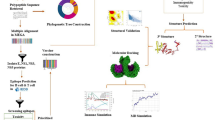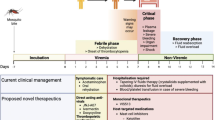Abstract
Dengue is an arboviral disease with no effective therapy available. Therefore, there is an urgent need to find a potent antiviral agent against dengue virus (DENV). In the present study, salidroside, a main bioactive compound of Rhodiola rosea, was evaluated for its antiviral potential against DENV serotype-2 infection and its effect on host innate immune factors. Antiviral effects of salidroside were examined in DENV-infected cells by western blotting, flow cytometry and real-time PCR. Its underlying mechanism involved in antiviral action was determined by evaluating expression of host innate immune factors including RIG-I, IRF-3, IRF-7, PKR, P-eIF2α and NF-κB. Salidroside potently inhibited DENV infection by decreasing DENV envelope protein expression more than tenfold. Salidroside exerts its antiviral activity by increasing expression of RNA helicases such as RIG-I, thereby initiating a downstream signaling cascade that induces upregulation of IRF-3 and IRF-7. It prevents viral protein synthesis by increasing the expression of PKR and P-eIF2α while decreasing NF-κB expression. It was also found to induce the expression of IFN-α. In addition, the number of NK cells and CD8+ T cells were also found to be increased by salidroside treatment in human PBMCs, which are important in limiting DENV replication during early stages of infection. The findings presented here suggest that salidroside exhibits antiviral activity against DENV by inhibiting viral protein synthesis and boosting host immunity by increasing the expression of host innate immune factors and hence could be considered for the development of an effective therapeutic agent against DENV infection.










Similar content being viewed by others
Change history
09 December 2021
A Correction to this paper has been published: https://doi.org/10.1007/s00705-021-05321-6
Abbreviations
- DENV:
-
Dengue virus
- IC50 :
-
Half-maximal inhibitory concentration
- RIG-I:
-
Retinoic acid inducible gene
- IRF-3:
-
Interferon regulatory factor 3
- PKR:
-
RNA-activated protein kinase
- P-eIF2α:
-
Phosphorylated eukaryotic initiation factor 2α
- NF-κB:
-
Nuclear factor kappa-light-chain-enhancer of activated B cells
- IFN-α:
-
Interferon alpha
- NK:
-
Natural killer cells
- DHF:
-
Dengue hemorrhagic fever
- DSS:
-
Dengue shock syndrome
- DC-SIGN:
-
Dendritic cell-specific ICAM3-grabbing non-integrin
- hPBMCs:
-
human peripheral blood mononuclear cells
- FBS:
-
Fetal bovine serum: MOI: multiplicity of infection
- MTT:
-
3-(4,5-Dimethyl-2-thiazolyl)-2,5-diphenyltetrazoliumbromide
- NO:
-
Nitric oxide
- TNF-α:
-
Tumor necrosis factor alpha
References
Beltrán D, Vergès SL (2014) NK cells during dengue disease and their recognition of dengue virus-infected cells. Front Immunol 5:1–6
Cheng YL, Lin YS, Chen CL, Wan SW, Ou YD, Yu CY, Tsai TT, Tseng PC, Lin CF (2015) Dengue virus infection causes the activation of distinct NF-κB pathways for inducible nitric oxide synthase and TNF-α expression in RAW264.7 cells. Mediators Inflamm 2015:1–13
Cologna R, Armstrong PM, Rico-Hesse R (2005) Selection for virulent dengue viruses occurs in humans and mosquitoes. J Virol 79:853–859
Diwaker D, Mishra KP, Ganju L, Singh SB (2014) Rhodiola inhibits dengue virus multiplication by inducing innate immune response genes RIG-I, MDA5 and ISG in human monocytes. Arch Virol 159:1975–1986
Edelman R (2007) Dengue vaccines approach the finish line. Clin Infect Dis 45:S56–S60
Fried JR, Gibbons RV, Kalayanarooj S, Thomas SJ, Srikiatkhachorn A, Yoon IK, Jarman RG, Green S, Rothman AL, Cummings DA (2010) Serotype-specific differences in the risk of dengue hemorrhagic fever: an analysis of data collected in Bangkok, Thailand from 1994 to 2006. PLoS Negl Trop Dis 4:1–6
Gack MU (2014) Mechanisms of RIG-I-like receptor activation and manipulation by viral pathogens. J Virol 88:5213–5216
Guan S, Feng H, Song B, Guo W, Xiong Y, Huang G, Zhong W, Huo M, Chen N, Lu J, Deng X (2011) Salidroside attenuates LPS-induced pro-inflammatory cytokine responses and improves survival in murine endotoxemia. Int Immunopharmacol 11:2194–2199
Guy B, Barrere B, Malinowski C, Saville M, Teyssou R, Lang J (2011) From research to phase III: preclinical, industrial and clinical development of the Sanofi Pasteur tetravalent dengue vaccine. Vaccine 29:7229–7241
Guzman MG, Vazquez S (2010) The complexity of antibody-dependent enhancement of dengue virus infection. Viruses 2:2649–2662
Halstead SB (1989) Antibody, macrophages, dengue virus infection, shock, and hemorrhage: a pathogenetic cascade. Rev Infect Dis 11:S830–S839
Henchal EA, Putnak JR (1990) The Dengue viruses. Clin Microbiol Rev 3:376–396
Hidari KI, Takahashi N, Arihara M, Nagaoka M, Morita K, Suzuki T (2008) Structure and anti-dengue virus activity of sulfated polysaccharide from a marine alga. Biochem Biophys Res Commun 376:91–95
Hiscott J, Kwon H, Génin P (2001) Hostile takeovers: viral appropriation of the NF-κB pathway. J Clin Investig 107:143–151
Jassim SAA, Naji MA (2003) Novel antiviral agents: a medicinal plants perspective. J Appl Microbiol 95:412–427
Latifah S, Abd Kadir A, Yaakob H, Zulkifli RM (2013) Potential anti-dengue medicinal plants: a review. J Nat Med 67:677–689
Lee Y, Jung JC, Jang S, Kim J, Ali Z, Khan IA, Oh S (2013) Anti-inflammatory and neuroprotective effects of constituents isolated from Rhodiola rosea. Evid-Based Complement Altern Med 2013:1–9
Li X, Sipple J, Pang Q, Du W (2012) Salidroside stimulates DNA repair enzyme Parp-1 activity in mouse HSC maintenance. Blood 119:4162–4173
Martina BEE, Koraka P, Osterhaus ADME (2009) Dengue virus pathogenesis: an integrated view. Clin Microbiol Rev 22:564–581
Mishra KP, Sharma N, Diwaker D, Ganju L, Singh SB (2013) Plant derived antivirals: a potential source of drug development. J Virol Antivir Res 2:1–9
Mishra KP, Ganju L, Singh SB (2012) Anti-cellular and immunomodulatory potential of aqueous extract of Rhodiola imbricate rhizome. Immunopharmacol Immunotoxicol 34:513–518
Platanias LC (2005) Mechanisms of type-I- and type-II-interferon- mediated signaling. Nat Rev Immunol 5:375–386
Qi RF, Zhang L, Chi CW (2008) Biological characteristics of dengue virus and potential targets for drug design. Acta Biochim Biophys Sin 40:91–101
Sadler AJ, Williams BR (2007) Structure and function of the protein kinase R. Curr Top Microbiol Immunol 316:253–292
Sanchez EN, Despres P, Barron LC (2005) Innate immune responses to dengue virus. Arch Med Res 36:425–435
Sun JC, Lanier LL (2011) NK cell development, homeostasis and function: parallels with CD8+ Tcells. Nat Rev Immunol 11:645–657
Wang H, Ding Y, Zhou J, Sun X, Wang S (2009) The in vitro and in vivo antiviral effects of salidroside from Rhodiola rosea L. against coxsackievirus B3. Phytomedicine 16:146–155
Wu SJ, Grouard-Vogel G, Sun W, Mascola JR, Brachtel E, Putvatana R, Louder MK, Filgueira L, Marovich MA, Wong HK, Blauvelt A, Murphy GS, Robb ML, Innes BL, Birx DL, Hayes CG, Frankel SS (2000) Human skin Langerhans cells are targets of dengue virus infection. Nat Med 6:816–820
Yu P, Hu C, Meehan EJ, Chen L (2007) X-ray cyrstal structure and antioxidant activity of salidroside, a phenylethanoid glycoside. Chem Biodivers 4:508–513
Zandi K, Teoh BT, Sam SS, Wong PF, Mustafa MR, Abubakar S (2012) Novel antiviral activity of baicalein against dengue virus. BMC Complement Altern Med 12:214
Zuo G, Li Z, Chen L, Xu X (2007) Activity of compounds from Chinese herbal medicine Rhodiola kirilowii (Regel) Maxim against HCV NS3 serine protease. Antivir Res 76:86–92
Acknowledgments
The authors thank the Defense Research & Development Organization (DRDO), Ministry of Defence, Government of India, for financial support in the form of DIP-264. NS thanks the Council of Scientific and Industrial research for providing a fellowship in the form of a junior and senior research fellowship.
Author information
Authors and Affiliations
Corresponding author
Ethics declarations
Conflict of interest
The authors have no conflict of interest.
Rights and permissions
About this article
Cite this article
Sharma, N., Mishra, K.P. & Ganju, L. Salidroside exhibits anti-dengue virus activity by upregulating host innate immune factors. Arch Virol 161, 3331–3344 (2016). https://doi.org/10.1007/s00705-016-3034-1
Received:
Accepted:
Published:
Issue Date:
DOI: https://doi.org/10.1007/s00705-016-3034-1




